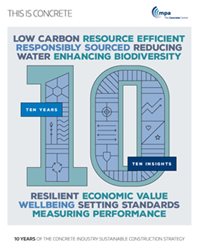11 Jul 2018
The UK Concrete Industry Sustainable Construction Strategy reached a key milestone in July 2018, with a stakeholder event at the Royal Festival Hall on 4th July to mark 10 years of this important initiative.
A few weeks ahead of schedule, as the strategy was formally signed on 30 July 2008, the concrete industry welcomed representatives from the supply chain and the built environment to St Paul’s Roof Pavilion, Royal Festival Hall, Southbank to hear from Andy Spencer, Chair of the Sustainable Concrete Forum and John Davies - Head of Sustainability, Derwent Group.
Andrew Minson, Executive Director of The Concrete Centre welcomed guests and encouraged them to celebrate icons of the past, present and future in concrete.
The evening saw the launch of the new This is Concrete magazine, 10 Years, 10 Insights which documents the sustainability achievements of the concrete industry over the past 10 years, since the strategy was launched.
Andy Spencer summarised the concrete industry’s achievements while John spoke about the provision of office buildings and using concrete to achieve wellbeing through its thermal mass; flexibility; as well as robustness for long term use.
Andy revealed the 10 Insights using viewpoints, case studies and interviews with members of exemplar concrete project teams, demonstrating how concrete is: low carbon; resource efficient; responsibly sourced; reducing water consumption; enhancing biodiversity; resilient; economic value; increasing wellbeing; setting standards; and measuring performance.
INSIGHT #1: CARBON - The embodied carbon of concrete has reduced by 28% since 1990.
Case study example: The recent refurbishment of Centre Point in London demonstrates the longevity of concrete structures - a key factor in assessing whole-life performance. While the glazing had to be upgraded, the precast cladding panels only needed to be cleaned.
INSIGHT #2: RESOURCE EFFICIENCY - The concrete industry is a net consumer of waste.
Case study example: Exposed concrete structures are robust, long-lasting and material efficient because there is no need for additional finishes. This makes them an increasingly popular option for university buildings such as The Exchange in Falmouth by Burwell Deakins Architects.
INSIGHT #3: RESPONSIBLE SOURCING - More than 90% of BES 6001 certified concrete is rated Very Good or Excellent.
Case study example: Over 200,000 concrete segments line the 42km of tunnels of London’s new east-west Elizabeth Line. All materials on Crossrail had to be procured to high ethical standards. The concrete industry was able to demonstrate compliance because concrete is both locally sourced, and the BES 6001 standard has been widely adopted.
INSIGHT #4: WATER - The concrete industry has cut mains water consumption by almost 10%.
Case study example: Concrete block permeable paving addresses both flooding and pollution by attenuating and cleaning water run-off at source. Peterborough City Council has trialled this approach at Fleetwood Crescent, a development for Cross Keys Homes. The drainage is designed to temporarily store rainwater run-off on site and remove pollutants before gradual discharge to a surface-water sewer that eventually outfalls into a nearby watercourse.
INSIGHT #5: NATURAL ENVIRONMENT - More than 99% of relevant sites have a biodiversity action plan.
Case study example: Members of the Mineral Products Association manage or control over 115 square miles of land. Scores of wild places, are now open to the public as part of the MPA National Nature Park, launched in 2013. Tarmac has also trialled the government’s Corporate Natural Capital Accounting Framework at its Mancetter quarry in Warwickshire. The innovative methodology highlighted the impact of its restoration projects, which have increased the renewable natural capital value of the site from £110,000 to over £3.5m.
INSIGHT #6: RESILIENCE - Concrete offers resilience in an uncertain future.
Case study example: The Hoola development in London Docklands by CZWG comprises two residential towers of 23 and 24 storeys. Both buildings have a concrete core that supports oval in-situ concrete floorplates and distinctive precast-concrete balconies. Concrete is a natural choice for apartment blocks because of its resistance to fire, strong acoustic properties and inherent thermal mass.
INSIGHT #7: ECONOMY - Concrete is essential to UK prosperity.
Case study example: The production and manufacture of concrete and its constituent materials supports regional and rural economies across the UK. The average transport distance of ready-mixed concrete from plant to site is just 12km. In 2016, the average delivery distance for all types of concrete was 45km, and 57km for all of its raw materials.
INSIGHT #8: WELLBEING - Concrete structures and finishes can improve quality of life.
Case study example: In Hanson’s new ready-mixed concrete trucks, a lower driving position and panoramic glass cab gives drivers better visibility of cyclists and pedestrians, improving road safety. They also run on hybrid fuel, helping to lower carbon emissions from transport.
INSIGHT #9: STANDARDS AND BENCHMARKING - Concrete goes above and beyond compliance.
Case study example: BREEAM Outstanding Five Pancras Square's exceptional environmental performance is underwritten by extensive use of concrete.
INSIGHT #10: PERFORMANCE METRICS - Ten years of detailed sustainability data has laid a foundation for the future.
Case study example: The refurbishment and extension of the Templeman Library at the University of Kent by Penoyre & Prasad has a concrete frame and a distinctive facade made up of precast concrete projecting fins. The project team’s shared use of data via collaborative BIM software made it possible for the precast contractor to develop the fins concurrently with the structural model, contributing to a successful outcome.
For full statistics and to read more please download a copy of the 10 Years, 10 Insights magazine.
